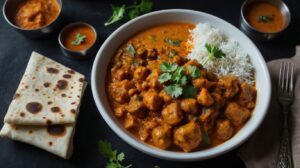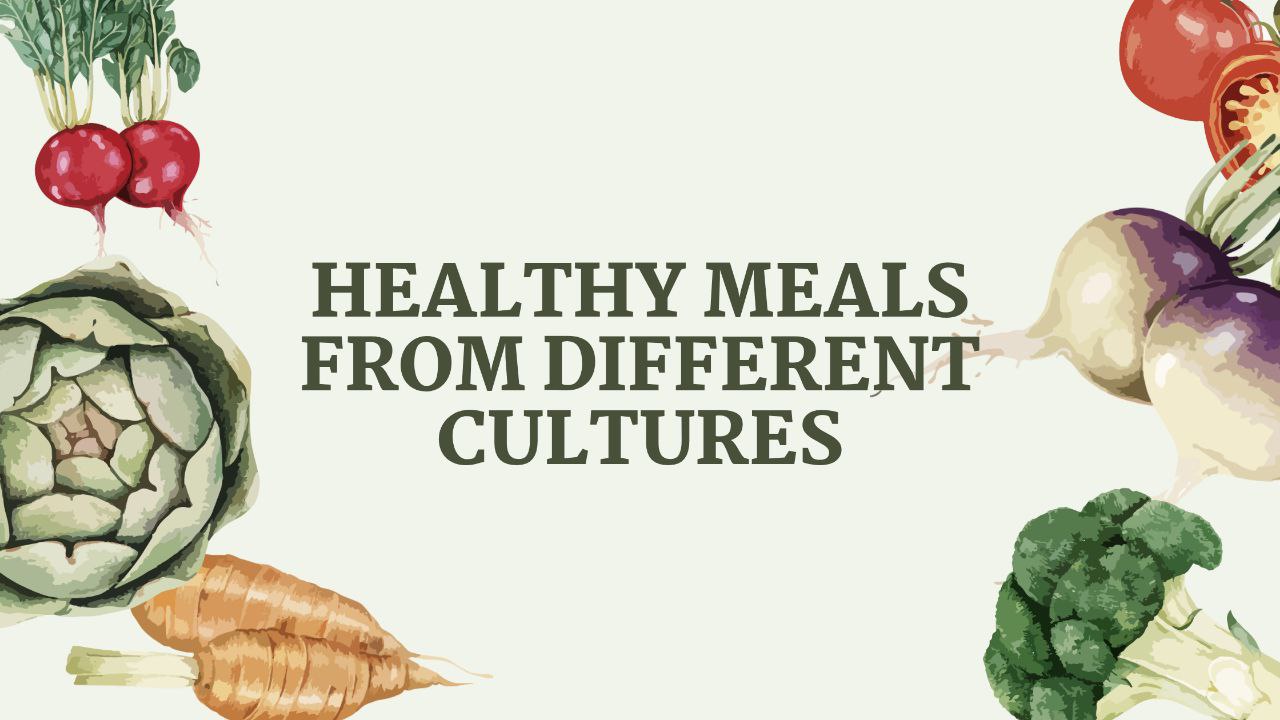Discover healthy meals from different cultures that are tasty, balanced, and easy to make. Explore global flavors while staying fit and nourished.
Introduction
In today’s fast-paced world, many people are searching for ways to stay healthy without giving up taste. One amazing way to do this is by exploring healthy meals from different cultures. Around the globe, traditional diets are packed with nutritious ingredients, balanced flavors, and time-tested methods that promote long life and wellness. Let’s explore how different countries keep their plates full of health and flavor.
Whether you’re on a journey to lose weight, manage a condition, or simply enjoy nutritious food, global meals offer incredible variety. The diversity of preparation styles, ingredients, and spices can not only improve your physical health but also enhance your mental satisfaction with meals.
Why Explore Healthy Meals from Different Cultures?
There are many benefits to adding global recipes to your diet:
- Variety of nutrients: Different cultures use unique vegetables, grains, and proteins.
- Less processed food: Traditional meals often rely on fresh ingredients and homemade preparation.
- Better digestion: Many world cuisines include naturally fermented or gut-friendly foods.
- Sustainable habits: These diets are usually in tune with the environment and local farming.
By learning about healthy meals from different cultures, you can not only improve your eating habits but also experience the joy of global flavors.
Additionally, cultural diets often carry generations of knowledge, offering therapeutic and seasonal benefits. For example, Indian meals use warming spices in winter, while Japanese summer foods are designed to cool the body.
Japanese Cuisine: Balanced Simplicity

Japanese meals are often considered some of the healthiest in the world. A traditional Japanese meal includes:
- Fish or tofu for protein
- Steamed rice or soba noodles
- Miso soup (fermented, gut-friendly)
- Vegetables like spinach, seaweed, or daikon
Why it’s healthy:
- Low in saturated fats
- Rich in omega-3s
- Controlled portion sizes
Tip: Try a simple miso soup with tofu, scallions, and wakame for a quick boost to your gut health.
Japanese meals also emphasize “Hara Hachi Bu” – eating until you are 80% full, a practice that helps with digestion and weight control. Green tea is also a regular part of the diet, offering antioxidants and a calming effect.
Mediterranean Diet: Heart-Healthy and Flavorful

The Mediterranean diet, common in Greece, Italy, and Spain, is known for its heart-healthy benefits. A typical meal includes:
- Olive oil as the main fat
- Whole grains like farro or bulgur
- Legumes and beans
- Grilled fish or chicken
- Fresh vegetables and fruits
Why it’s healthy:
- Rich in healthy fats
- Anti-inflammatory ingredients
- Encourages plant-based eating
Healthy Recipe Idea: Greek salad with tomatoes, cucumber, olives, feta, and a drizzle of olive oil.
This diet also emphasizes social eating, with meals enjoyed slowly among friends and family. This promotes mindfulness and better digestion.
Indian Vegetarian Meals: Spiced Wellness

Many Indian households thrive on vegetarian meals rich in spices, legumes, and whole grains. Popular healthy dishes include:
- Dal (lentil soup)
- Chapati (whole wheat flatbread)
- Sabzi (vegetable curry)
- Raita (yogurt with cucumber and spices)
Why it’s healthy:
- High in fiber and plant protein
- Uses healing spices like turmeric and cumin
- Supports digestion
Quick Tip: Add turmeric and black pepper to your daily meals for anti-inflammatory benefits.
Indian meals often include a balance of six tastes: sweet, sour, salty, bitter, pungent, and astringent. This promotes complete nourishment and taste satisfaction.
Korean Cuisine: Fermented and Fresh

Korean meals include lots of vegetables, lean proteins, and fermented sides. A healthy Korean table often includes:
- Kimchi (fermented cabbage)
- Grilled chicken or tofu
- Brown rice or mixed grain rice
- Ssam (lettuce wraps with filling)
Why it’s healthy:
- Full of probiotics
- Rich in fiber
- Portion control with side dishes (banchan)
Healthy Habit: Make a batch of kimchi at home for gut health and immune support.
Many Korean meals also include soups and stews, often made from bones, which provide collagen and minerals essential for joint and skin health.
Mexican Traditional Meals: Colorful and Nutrient-Rich

Forget greasy Tex-Mex! Real Mexican food is full of nutrients. Try:
- Corn tortillas (gluten-free and whole grain)
- Beans for protein
- Avocado for healthy fats
- Salsa made from fresh veggies
- Grilled vegetables and meats
Why it’s healthy:
- High in fiber
- Uses healthy fats
- Natural ingredients
Healthy Meal: Black bean tacos with fresh salsa and avocado slices.
Traditional Mexican cuisine includes native superfoods like amaranth, chia seeds, and cactus (nopal), all of which have excellent health properties.
Ethiopian Cuisine: Plant-Based and Protein-Packed

Ethiopian food is often plant-based and served with injera, a sour flatbread made from teff. Typical healthy dishes:
- Misir wot (spiced lentils)
- Gomen (stewed greens)
- Shiro (chickpea stew)
Why it’s healthy:
- High in iron and plant protein
- Uses little oil
- Naturally gluten-free if teff is used
Try This: A simple lentil stew with garlic, onion, tomato, and berbere spice.
Ethiopian meals are typically served on a communal plate and eaten with hands, encouraging slower eating and greater satisfaction.
Thai Cuisine: Balanced and Fresh

Thai food can be very healthy when made traditionally. Key ingredients include:
- Lemongrass, basil, ginger, and chili
- Vegetables in coconut-based soups
- Steamed jasmine rice
- Grilled seafood or chicken
Why it’s healthy:
- Uses lots of herbs
- Fresh and light preparation
- Spices help with metabolism
Healthy Dish: Tom Yum soup with mushrooms, shrimp, lemongrass, and lime.
Thai cuisine also avoids processed ingredients and focuses on balance – sweet, salty, spicy, and sour flavors in harmony.
Lebanese Cuisine: Wholesome and Delicious

Middle Eastern meals, especially Lebanese, are rich in whole foods. Enjoy:
- Hummus and baba ganoush
- Tabbouleh (parsley and bulgur salad)
- Grilled meats like chicken kebabs
- Whole grain pita bread
Why it’s healthy:
- Fiber-rich
- Balanced carbs, fats, and proteins
- Full of antioxidants
Snack Tip: Use hummus as a dip for sliced cucumbers and carrots.
Lebanese meals often feature olive oil, lemon juice, and garlic – ingredients with powerful anti-inflammatory and immune-supporting benefits.
Tips to Incorporate Global Healthy Meals
- Try one new cultural dish each week
- Use herbs and spices to flavor food instead of salt
- Mix traditional and modern cooking styles
- Watch cooking videos from locals to get authentic techniques
- Shop at international markets to find fresh and unique ingredients
- Talk to people from those cultures to learn firsthand tips and traditions
Conclusion
Exploring healthy meals from different cultures is a fun and effective way to improve your diet. These meals are packed with nutrients, flavors, and traditions that can support your health and introduce you to new ways of eating. Whether it’s miso soup from Japan or lentil curry from India, global meals prove that healthy eating doesn’t have to be boring. Bon appétit!
Learning about healthy meals from different cultures not only satisfies your taste buds but also builds cultural understanding. Food is a universal language, and when it’s shared in a healthy way, it brings us all closer.
Ready to start your global food journey? Try one new healthy recipe this week and share your experience!







